![]()
| China | Beijing | 2002.07.03 - 07.09 |
Haze, Hills, and Hillbillies
Collect millions of countryside hillbillies, stick lavish government offices in the center, and voila, you have Beijing. Certainly, after seeing Hong Kong and Shanghai, Beijing seems like an overgrown Chinese country town. Traffic is a mess, clothing is drab, and bare bellied overweight men saunter about in short stockings and cheap black shoes. On top of that, the government's blanket policies create some needless minor inconveniences (many are simply stupid decisions) that over time pent frustration. One such inconvenience is installation of road median blockades without sufficient vehicle and pedestrian traffic flow passageways. Another annoyance when we were in Beijing was the blanket closure of all Internet points in the city due to a fire at one unregistered Internet business. Why should all the legal Internet businesses also be penalized? And why deny the entire population online communication "until further notice"?
We realized the best part about the rest of China is its remoteness from the central Beijing government. At least Internet is available in cities outside Beijing.
These impressions of Beijing, however, shouldn't discourage a visit. Several city sites are worth a look and the nearby Great Wall spanning the northern hills is a fantastic outing. In addition, with a few extra bucks, some Western luxuries can be had in city center, providing a temporary escape from the wearing characteristics of China.
City haze is common, and annually, a sand storm blankets the city for a day or two. On the rare clear day, the city feels habitable. All said and done, we had an enjoyable time in Beijing more due to fun dorm-mates Robert (German) and Lasse (Danish) than any particular activity.
TEMPLE OF HEAVEN
By far, one of the more beautiful structures in the world is the Temple of Heaven a few
kilometers southeast of Tiananmen Square. Surrounded by a huge 4 sq. km park, the conical
temple rises in the center. The tiered stone base of the temple is square, representing
earth. The temple itself is round, representing heaven. The geometry of construction
encompasses the heavenly number 9: 9 rings of 9 stones form the top tier, the number
of stairs are in multiples of 9.
The temple is open daily from 08:30~17:30 in the summer months. Shorter hours apply in off-season. Admission to the park is ¥15 and an additional ¥20 is collected at the temple. Alternatively, purchase a "through ticket" for ¥35 at the park entrance that gives access to both park and temple. No student discounts.
FORBIDDEN CITY
The middle of Beijing is a 1km x 2km palace that was residence to the emperors of the
Ming and Qing Dynasties. Primary buildings line the center north-south walkway starting
from Tiananmen Square. Admission is ¥40. An audio guide is an additional ¥40. No
student discount.
SUMMER PALACE
One hour by bus northwest of city center is the enormous Summer Palace. This park, with
giant man-made lake and aesthetic structures of varying design and size, takes a full day
to explore. Admission is ¥30 (¥15 with student card) to access most structures
at the Summer Palace. 3 or 4 temples within the Palace have separate admissions that cost
an additional ¥10 each.
THE GREAT WALL
The Great Wall is in fact many Great Walls built by many dynasties over a 2500 year period.
It extends more than 50,000 km (31,000 miles) across 17 provinces. Hotels in Beijing
sell transport to various nearby sections of the Great Wall. We selected transport
offered by the Fenglong Youth Hostel that dropped us off in Jinshanling and picked us up
in Simatai, 9km distant. This 9km walk along the wall was the highlight of our stay
in Beijing.
It's impossible to get lost walking the wall. Postcard and beverage vendors lurk at every watchtower hoping to make a good margin on tourists. People selling books, postcards, and other paraphernalia will claim that Simatai is only a short walk further. Naturally, they want you to buy and carry their product. The drinks vendors will claim that Simatai is extraordinarily distant hoping you stock on liquids. One elderly beverage vendor followed us repeating, "Cold-da! Cold-da! I go home!" He meant that if we buy cold water from him, he would go home. Poor guy was probably told to GO HOME by countless tourists over the past decade. We simply said, "You can walk with us. You can go home. We no buy." He decided to latch on to an obviously out-of-shape Englishman.
GETTING AROUND BEIJING
Vendors at the train station and hotels sell a map of Beijing in English and Chinese
characters with bus routes and subway stops. This ¥10 map is essential to navigate Beijing.
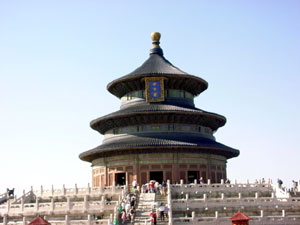 |
The Temple of Heaven has a tiered square base that represents earth and a circular building that represents heaven. Rainwater drains down each square tier through hundreds of dragon-faced spouts. The entire structure is constructed geometrically in multiples of 9, a heavenly number in Asian cultures. |
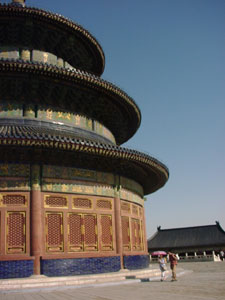 |
A close-up of the Temple of Heaven shows the detail in pattern and color. Overall, it's one of the more beautiful buildings we have seen in the world. |
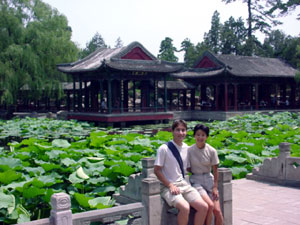 |
Wes and Masami relax by a lily pond in the Garden of Harmony at the Summer Palace. The Summer Palace is enormous; it would take a full day to walk its perimeter. |
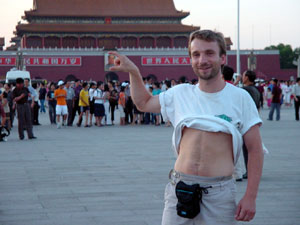 |
At Tiananmen Square, our dorm-mate Robert demonstrates how overweight Beijing hillbilly men wear shirts as he squashes Mao between his fingers. |
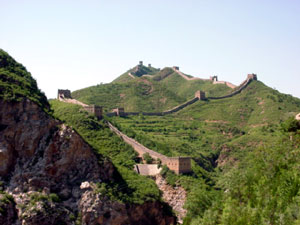 |
The Great Wall snakes over the hills across 17 provinces for a distance of over 50,000 km. Much of the wall north of Beijing is intact enough to walk along. Each square block along the wall is a watchtower. |
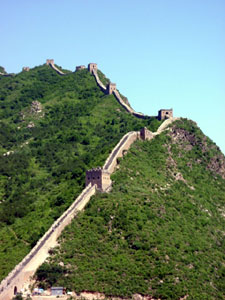 |
The section of Great Wall at Simatai, 110 km northeast of Beijing, is steep and mostly reconstructed for the hoards of visiting tourists. |
Copyright © 2000-2002 Wes and Masami Heiser. All rights reserved.